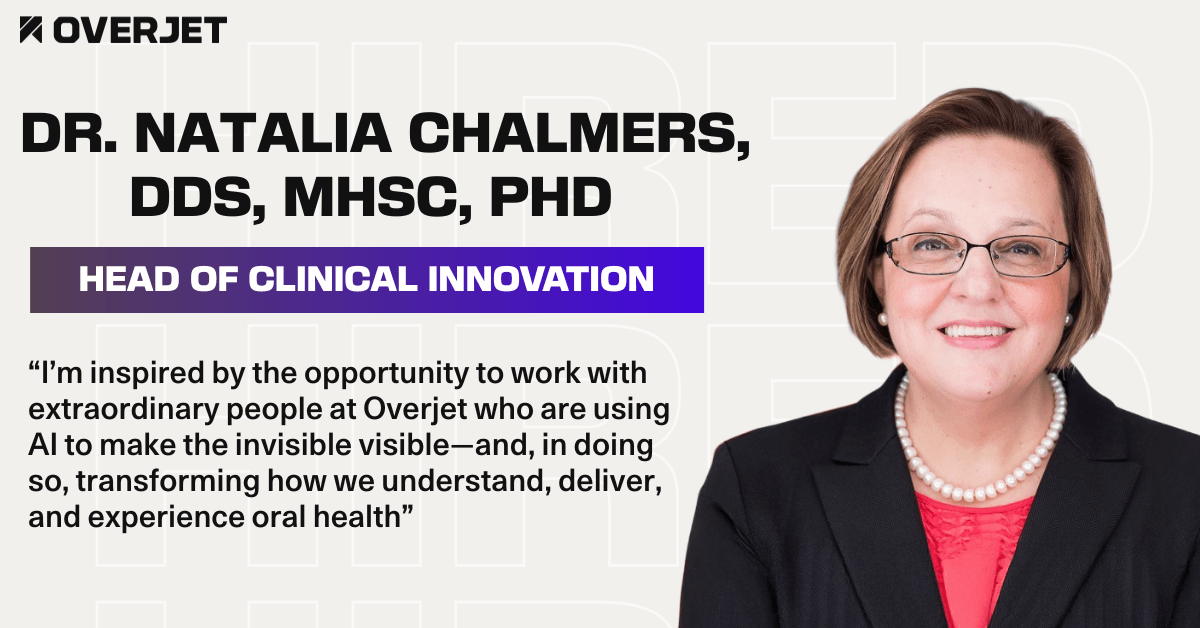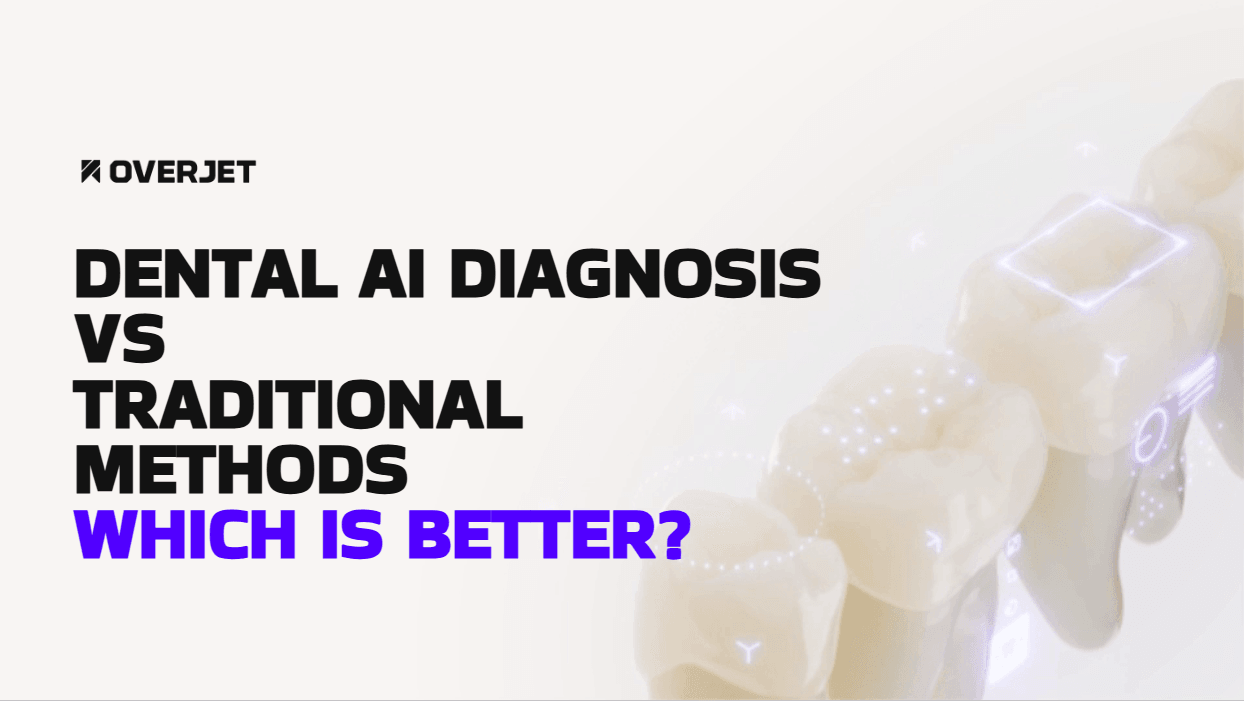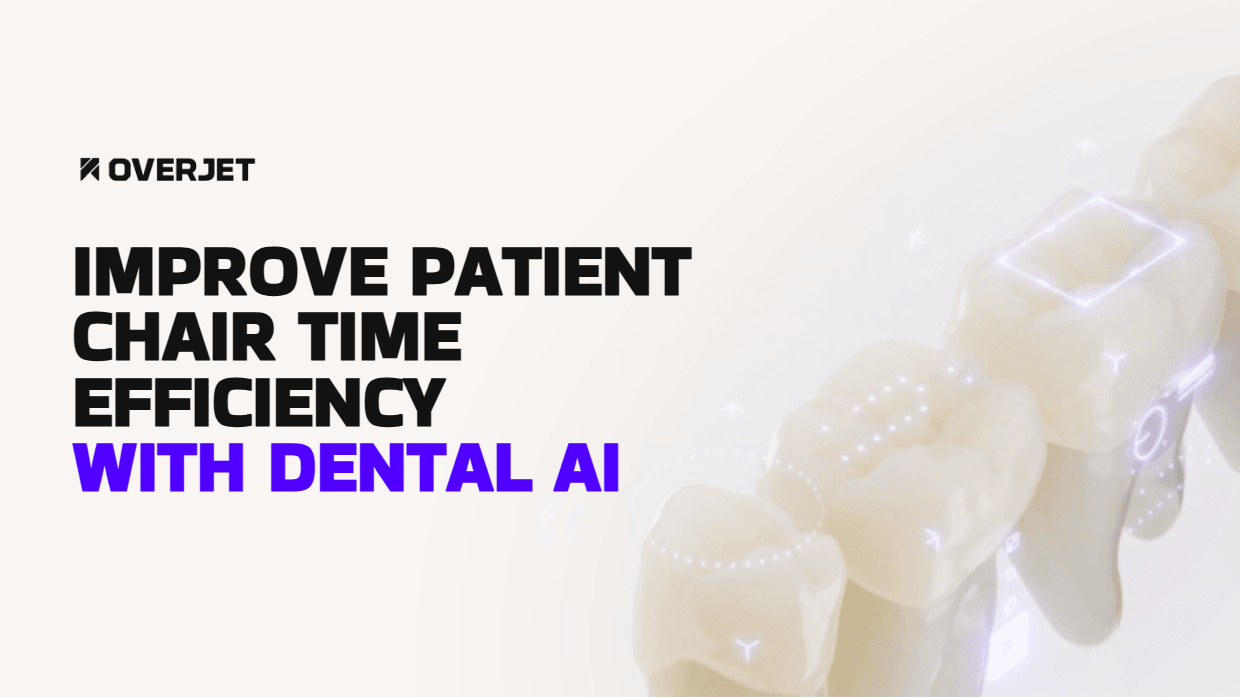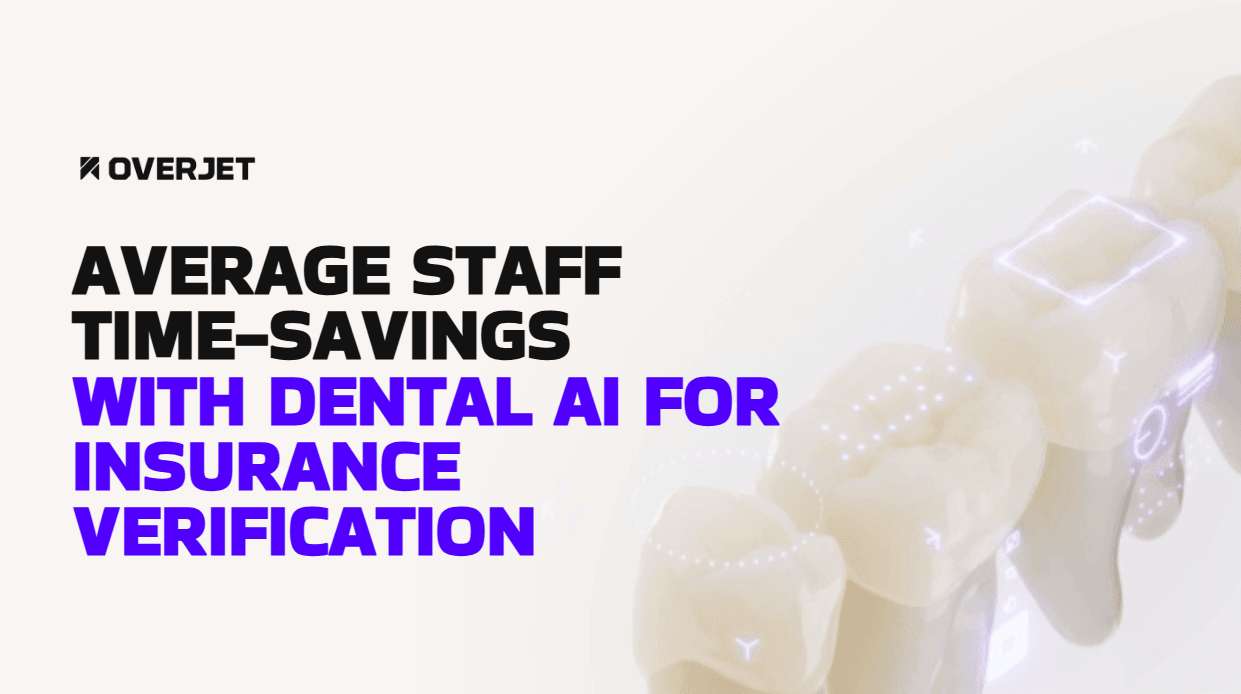Dental implant narratives determine whether insurance claims get approved or denied, yet many practices submit incomplete documentation that triggers unnecessary delays and revenue loss. A well-structured narrative connects clinical findings—bone measurements, functional impairment, and treatment history—to payer coverage criteria using patient-specific facts rather than generic justifications.
This guide covers the essential elements of implant narratives, proper CDT coding across surgical and restorative phases, step-by-step writing workflows, and how AI imaging tools like Overjet streamline documentation while improving approval rates.
Explore Overjet's Dental AI Software
What Is A Dental Implant Narrative
A dental implant narrative is structured documentation submitted with insurance claims that explains why a patient requires an implant and how the treatment addresses their specific condition. The narrative connects clinical findings—bone measurements, functional limitations, and prior treatment history—to the proposed implant placement in language that satisfies payer coverage criteria. Insurers review the narrative to determine whether the procedure qualifies as medically necessary rather than elective.
Clinical Vs Administrative Purpose
Clinical records live in your practice management system and capture the full scope of patient care: diagnosis codes, radiographic interpretations, treatment notes, and follow-up protocols. Administrative narratives translate those clinical details into focused justifications that address specific payer requirements. While your chart notes document everything about the case, the narrative extracts the elements insurers evaluate during claim review.
How Insurers Evaluate Medical Necessity
Payers look for objective evidence of bone loss at the extraction site, functional impairment that affects chewing or speech, and documentation showing why alternatives like bridges or removable partial dentures won’t work for the patient. They want a clear timeline: when the tooth was extracted, how long the site healed, and what diagnostics confirmed readiness for implant placement. Overjet’s AI measures bone levels on radiographs and CBCT scans, then generates annotated images that quantify vertical height and horizontal width—replacing subjective descriptions with reproducible data.
CDT Codes And Proper Use For Implant Claims
Accurate CDT coding across surgical and restorative phases prevents denials and ensures proper reimbursement. Each procedure requires the correct code paired with its service date, and the narrative ties each code back to clinical findings.
D6010 Surgical Placement
D6010 covers the surgical placement of an endosteal implant body once the extraction site has healed or when placing the implant concurrently with bone augmentation. The code applies to the implant fixture itself, not the abutment or crown. Your narrative clarifies timing relative to extraction and grafting dates.
D7953 Ridge Preservation
D7953 applies to bone graft placement at the time of extraction to preserve ridge dimensions for future implant placement. Document the defect size in millimeters, the graft material—allograft, xenograft, or synthetic—and whether a membrane was placed to guide tissue regeneration.
D6065 Implant Crown
D6065 covers an implant-supported porcelain or ceramic crown after successful osseointegration and abutment placement. Pair this code with the appropriate abutment code when billing separately, and reference the implant placement date to show the complete treatment sequence.
D6080 Maintenance Visit
D6080 applies to implant maintenance procedures: evaluation of peri-implant tissues, prosthesis removal when indicated, debridement, and occlusal assessment. Payer policies vary on frequency and coverage, so the narrative explains why the maintenance visit was clinically indicated at that interval.
Essential Elements Of Dental Narratives That Work
Effective narratives establish medical necessity using patient-specific facts, objective diagnostics, and precise coding with dates. Generic language that fails to explain why this particular patient requires this particular treatment often triggers denials.
Diagnosis And Tooth Number
Include the exact tooth number or edentulous site and the reason for tooth loss: trauma, vertical root fracture, non-restorable decay, or advanced periodontitis. Linking the diagnosis to the need for implant therapy helps insurers understand that extraction was necessary, not elective, and that implant placement represents the appropriate restorative option.
Extraction And Graft Dates
List extraction and graft dates to show a logical treatment sequence and appropriate healing intervals before implant placement. Insurers look for evidence that the site was allowed to heal—typically 8 to 16 weeks for ridge preservation, longer for more extensive grafting—before proceeding with implant surgery.
Supporting Diagnostics And Images
Reference periapical radiographs, CBCT scans, and clinical photos that demonstrate bone volume, defect morphology, and anatomical considerations like the inferior alveolar nerve or maxillary sinus. Overjet’s AI analysis provides quantitative bone level measurements and annotated images that substantiate clinical findings with objective data, making it easier for reviewers to verify what you observed when planning the case.
Step-By-Step Writing Workflow For Implant Placement Narratives
A consistent workflow ensures complete, payer-ready documentation every time. First, gather all diagnostics before writing. Collect periapicals, CBCT slices, periodontal charting, clinical photos, and relevant medical and dental history. Confirm tooth numbers, prior procedure dates, and materials used for any grafting or provisional restorations.
Next, draft a medical necessity statement that ties the patient’s condition—defect type, functional impairment, and why alternatives like bridges or removable prosthetics won’t work—to the implant plan. Support the statement with objective measurements from radiographs or Overjet AI annotations. This justification answers the insurer’s core question: why is an implant medically necessary for this patient?
Then, insert specific CDT codes with dates for extraction, grafting, implant placement, abutment, and crown. Cross-reference the narrative with the claim form so there’s no discrepancy between what you’re billing and what you’re describing.
Finally, attach radiographs, CBCT images, photos, periodontal charting, and Overjet AI annotations. Submit through the carrier’s designated portal with all required forms and narratives. Double-check that image quality is high enough for reviewers to see anatomical landmarks and implant positioning clearly.
Dental Implant Narrative Sample For Initial Placement
Here’s an example that combines patient history, diagnostics, and surgical details in one concise narrative.
Patient: Jane Doe, DOB: 05/12/1978; Tooth/Area: #19. Tooth lost due to vertical root fracture on 02/15/2024. Ridge preservation with freeze-dried bone allograft and resorbable collagen membrane completed on 02/15/2024; uneventful healing confirmed at 4-month follow-up. Current CBCT on 06/20/2024 demonstrates 10.0 mm vertical height above the inferior alveolar nerve and 7.5 mm horizontal width at the crest; Overjet AI analysis confirms bone dimensions and highlights prior bone loss at the edentulous site. The patient reports functional impairment with mastication on the left side and lacks suitable abutment teeth for a fixed partial denture; a removable prosthesis is contraindicated due to poor retention and patient preference for a fixed solution.
Plan: D6010 endosteal implant placement at site #19. Implant: Nobel Biocare 4.3 x 10 mm, torque achieved 35 Ncm, healing abutment placed. Alternatives including RPD and bridge discussed; patient elected implant due to improved function and long-term prognosis. Medical necessity is based on restoration of function, stabilization of occlusion, and prevention of further ridge resorption. Codes and dates: D6010 on 07/10/2024; prior D7953 on 02/15/2024. Supporting images: periapical and CBCT attached with Overjet AI measurements and annotations.
Key narrative components:
Patient history: Extraction date and reason for tooth loss establish the timeline
Clinical findings: Bone measurements from CBCT provide objective evidence
Surgical procedure: Implant specifications and placement technique demonstrate technical competence
Post-operative instructions: Healing timeline and follow-up schedule show continuity of care
Implant Crown Narrative And Related Restorations
After osseointegration—typically 3 to 6 months depending on bone quality and graft integration—document the restorative phase, including abutment selection, crown type, and functional outcomes.
Tooth/Site: #19. Implant placed on 07/10/2024 with successful osseointegration confirmed clinically and radiographically on 11/05/2024. Soft tissue is healthy with 3 mm of stable keratinized tissue. Abutment: titanium custom abutment, torque 35 Ncm. Final restoration: D6065 implant-supported zirconia crown, fabricated via CAD-CAM, shade A3, screw-retained for retrievability. Occlusion adjusted for mutually protected scheme; patient instructed on implant hygiene and maintenance protocol. Medical necessity: restoration of function and prevention of supraeruption of opposing tooth #3. Supporting images and Overjet AI bone-level verification attached.
Crown Type | Material | Indications |
Porcelain-fused-to-metal | PFM | Posterior teeth requiring high strength |
All-ceramic | Zirconia or lithium disilicate | Anterior aesthetics, metal allergies |
Screw-retained | Various materials | Retrievability, maintenance access |
Bone Graft Narrative And Ridge Preservation Template
When augmentation is required—whether at extraction or before implant placement—document defect characteristics, materials, and healing protocol so insurers understand why the graft was medically necessary.
Patient: John Smith, Site: #8. Post-extraction ridge shows 4 mm horizontal loss and 3 mm vertical deficiency per CBCT dated 03/10/2024; Overjet AI quantifies crestal width at 4.2 mm, insufficient for standard-diameter implant. Procedure on 03/10/2024: D7953 ridge preservation with freeze-dried bone allograft, particle size 250–1000 microns, resorbable collagen membrane placed and secured with tacks; primary closure achieved with tension-free flap advancement. Healing expected in 12 weeks prior to D6010. Medical necessity: preserve ridge for implant stability and to avoid future staged augmentation. Follow-up visits scheduled for 04/07/2024 and 06/02/2024; images attached with AI annotations showing defect dimensions.
Graft documentation essentials:
Bone defect assessment: Measure horizontal and vertical bone loss in millimeters
Graft material: Specify autograft, allograft, xenograft, or synthetic with particle size
Membrane placement: Document barrier membrane use and fixation method
Healing protocol: Outline integration timeline before implant placement
Attachments And Radiographic Evidence Payers Expect
Comprehensive, clear documentation visually supports the narrative and codes, making it easy for reviewers to verify clinical findings without requesting additional information. Submit pre- and post-op periapicals and key CBCT slices showing bone height and width, anatomical landmarks like the inferior alveolar nerve or maxillary sinus, and implant positioning. Overjet AI adds automated linear measurements and annotations to objectively demonstrate adequacy of bone and implant angulation, reducing subjective interpretation and speeding claim review.
Include periodontal charting to show soft tissue health—probing depths, bleeding on probing, and keratinized tissue width—and clinical photos for tissue phenotype and emergence profile, especially for anterior cases where aesthetics affect treatment planning and prognosis.
Common Mistakes That Trigger Claim Denials
Omissions and generic phrasing that fail to demonstrate medical necessity are the most common reasons for denials or requests for additional information. Always list precise tooth or site numbers and all relevant service dates—extraction, grafting, implant, abutment, crown—so reviewers can follow the treatment sequence without guessing. Even a single missing date can delay approval by weeks.
Use patient-specific findings and measurements rather than boilerplate statements like “patient needs implant for function.” Explain why alternatives are unsuitable for this patient—inadequate abutment teeth, patient refusal of removable prosthesis, or failed prior treatment.
Common errors to avoid:
Generic templates: Copy-paste narratives without customization fail to address individual patient circumstances
Missing timelines: Include all relevant procedure dates in chronological sequence
Insufficient justification: Provide specific medical reasons, not just procedural descriptions
Poor image quality: Radiographs that don’t clearly show anatomical structures and implant positioning
Tips To Improve Approval Rates With AI Imaging
Technology makes narratives objective and verifiable, reducing payer skepticism and back-and-forth requests for clarification. Overjet’s AI provides reproducible bone height and width measurements and tracks changes over time, improving payer confidence that clinical findings are accurate rather than subjective estimates. Automated measurements also save chair time, allowing comprehensive documentation generation in seconds rather than manually measuring and annotating images.
Visual overlays on radiographs and CBCT scans help patients understand their condition and the rationale for implant treatment, improving case acceptance and ensuring documentation reflects informed consent. When patients see annotated images showing bone loss or defect dimensions, they’re more likely to proceed with treatment.
Ready to streamline your implant narratives?
Book a demo to see how Overjet AI auto-populates narratives with measurements, images, and coding cues.
The ROI Of Strong Narratives On Cash Flow
Quality documentation reduces denials, accelerates payments, and improves revenue cycle efficiency, directly impacting practice financial health. Well-documented implant claims commonly achieve approval rates above 85 percent, depending on payer mix and plan specifics. Using objective measurements from Overjet AI and complete timelines reduces medical review holds and speeds first-pass approval.
Complete narratives with proper codes, dates, and attachments reduce re-submissions and cut accounts receivable days by 10 to 30 percent, improving cash flow and freeing staff from follow-up calls and appeals. When claims are right the first time, the team spends less time on administrative work and more time on patient care.
Advance Patient Care And Claims Accuracy With Overjet AI
Overjet AI streamlines evidence collection, adds objective measurements to images, and helps standardize narratives across the team, improving both clinical communication and claims accuracy. By automating the most time-consuming parts of narrative writing—measurements, annotations, and coding suggestions, Overjet allows focus on patient care while ensuring every claim is backed by reproducible data.
Ready to See Overjet's Dental AI in Action?
Frequently Asked Questions (FAQs)
How long should a dental implant narrative be for insurance claims?
A comprehensive implant narrative typically covers patient history, clinical findings, and treatment rationale in one to two paragraphs—detailed enough to justify medical necessity while remaining concise and easy for reviewers to scan quickly.
Does Medicare Advantage ever cover dental implant procedures?
Most Medicare Advantage plans exclude dental implants as elective procedures, though coverage can vary significantly by plan, and some plans may offer limited coverage for accident-related tooth loss or when the implant is integral to treating a covered medical condition like oral cancer reconstruction.
Can I reuse the same narrative template for different insurance carriers?
While basic narrative structure remains consistent, each claim requires customization with patient-specific details. Different carriers may emphasize different criteria—some focus on functional impairment, others on failed alternatives—so tailor the justification to the payer’s coverage policy.









